I have been experiencing a slow ascent back to sanity that took about 30 years.
Until about five years ago I believed I had “bipolar disorder” — I had taken every medication on the market and tried every intervention psychiatry has to offer, but I had become “treatment resistant.” The false belief that I have a chronic and disabling mental health condition was a falsehood that was spoon-fed to my parents by the child and adolescent psychiatrists of the early 1990s, and blindly reinforced by so very many since.
In addition to being brainwashed and gaslit by everyone around me, I was also functioning in a disassociated state from trauma that placed a widening gap between me and the rest of the world that has lasted for 30 years. The Covid-19 pandemic has helped me to break free from the bondage of an absurd misrepresentation of reality and face an injustice imposed upon me by an industry that uses the ICD coding system and the DSM as weapons to steal the voices of the young.
The pandemic has been hard for everyone, but I was unknowingly sitting on a ticking time bomb of trauma that was about to rear its ugly head. I was triggered by the sudden shift in my reality, a world that instantly changed and caused massive isolation in my already somewhat isolated existence. I also lost contact with “TB,” the only psychiatrist I had had to date that could actually see me for who I was, and not only un-diagnosed me in 2017, but eventually told me I likely never needed a psychiatrist to begin with and encouraged me to seek other methods of healing like EMDR and other natural ways to find and regain homeostasis.
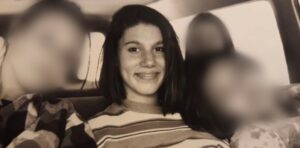
Destined for a life of pharma
When I was three weeks old, I was reportedly “particularly fussy” — I cried a lot and could not sleep. I was given phenobarbital drops by my 1970s pediatrician and diagnosed with colic. Despite the fact that my parents were former hippies who insisted on a simple, natural lifestyle free of pesticides or refined sugar, they listened to the doctor and poured the drops down my young throat so we could all get a good night’s rest.
I had a lot of health problems as a child and by 1988 I was in the hospital for an idiopathic pain syndrome that was ultimately diagnosed as neurovascular dystrophy and amplified pain. Until that time, I had been dragged from one doctor to the next and been given countless rounds of antibiotics, had missed a lot of school, and had a specialist for many of my body systems. The treatment plan for my pain syndrome was intense physical therapy, exercise, diet changes, and counseling to learn stress management. During that hospital stay I was referred to a neuropsychologist who ran a battery of psychological tests.
My inpatient neuropsychiatric testing contradicted previous tests I had had in the second grade that placed my IQ at 135 and indicated that I was a gifted, creative, and imaginative young lady with some significant learning disabilities that would likely resolve with an individualized educational plan. Instead, my IQ had plummeted in those few years and, by the time I was 13, I was seemingly no longer gifted. They recommended more counseling, and that ended up being the bridge between body and brain that I almost never crossed again.
At age 13 I also experienced a sexual trauma and as a result I was bullied at school, ostracized by my peers, and labeled a slut. I lost all of the friends I had had since preschool almost overnight. I was fighting with my parents and struggling with emotional and behavioural issues. After bouncing around between a few therapists, I was eventually taken to a child and adolescent psychiatrist named Dr. M. Once again, my parents turned to doctors to fix me, and Dr. M was the best that money could buy.
I only recently discovered that Dr. M also worked as a private consultant for sexual deviance programmes in the justice system. She was an expert witness in the courts, specializing in the ability to correlate extreme criminal behaviours with bipolar disorder, a disorder that was picking up steam in the world of child psychology at the time and one that would land her on several high-profile court cases. According to Dr. M, bipolar disorder was the magic bullet that explained all of my behaviour. A one-size-fits-all diagnosis for the struggling teen, and I would go on to carry that label and its stigma for much of my life.
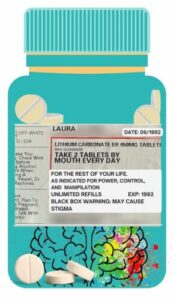 Dr. M was also the medical director of an adolescent mental health facility in my town, and in no time at all I went from reading Wuthering Heights in my prep school English class to attending group therapy and journaling endlessly in an inpatient mental hospital under her care. By 1992 they were forcing lithium down my throat and making me open up my mouth to ensure the pills were gone. At age 14, I was taking 600 mg of lithium and 750 mg of Depakote daily and was officially branded with a bipolar diagnosis due to my “mood swings,” sleep issues, and “hypersexual” behaviour.
Dr. M was also the medical director of an adolescent mental health facility in my town, and in no time at all I went from reading Wuthering Heights in my prep school English class to attending group therapy and journaling endlessly in an inpatient mental hospital under her care. By 1992 they were forcing lithium down my throat and making me open up my mouth to ensure the pills were gone. At age 14, I was taking 600 mg of lithium and 750 mg of Depakote daily and was officially branded with a bipolar diagnosis due to my “mood swings,” sleep issues, and “hypersexual” behaviour.
I was also forced to take Depo-Provera shots, even though I felt they made my symptoms worse; like women centuries before, I had been labeled a hysteric, sterilized and locked away, all for the crime of being female. I only recently discovered that many of my issues originate from hormonal fluctuations and that Depo-Provera was likely the worst medication to place me on due to its action on progesterone. Progesterone affects dopamine, which is the sad, lonely neurotransmitter that was always overlooked in all of my medication trials and as of late, has saved me from plummeting into the darkest of places.
I realize now that my voice was being actively stolen from me with every trip to the doctor, from the day I was born. Dr. M always left me feeling manipulated and rearranged, as if I were a frog in biology class that had been dissected and put back together in the wrong order. I was dipped in formaldehyde and pinned to a board, my heart where my lungs should be and my brain in a jar beside me.
Although I don’t remember a lot of the specific details of my interactions with Dr. M, I distinctly remember messaging around a few topics that would begin to shape my perceptions of myself as a sick, dangerous person, and an unreliable teller of my own story.
-
I could not have children with this diagnosis (which I did not) because I would experience too many mood fluctuations during the postpartum period and could potentially be a risk of harm to the children, and
-
When Kurt Cobain died by suicide it was presented to me as an inevitability of my condition, that I too would kill myself if I did not take my lithium, because Kurt died from not taking his lithium.
By then I had unknowingly fallen right into the lap of pharmaceutical industry, and it was there I would sit, quite uncomfortably, for decades. At that time my parents were scared for my life, and they would have done anything to ‘save’ me. Dr. M had convinced me to voluntarily sign myself into treatment at her psychiatric facility — at that time I didn’t understand that I had rights in my state, and that they couldn’t keep me against my will without a court order. It was one of many manipulations that would pave the way for the egregious human rights violations that followed.
I was removed from my prep school and placed in lockdown for 60 days. I also did not understand that I had just been institutionalized for a severe mental illness, and from that moment forward I was “mentally ill,” whether science supported it or not.
While I was in the hospital I saw Dr. M weekly for individual therapy, I went to group, my roommate had multiple personalities, I went to arts and crafts hour, I saw a child with Tourette syndrome come screaming and crying out of his room because he was raped by another patient with the craft pencils, I saw adults do nothing about the rape, I wrote in my journal, I shared my feelings, I got “stabilized” on my medications, and I did family therapy with my terrified parents who clung to every word the doctor said that would explain my erratic behaviour and poor decision making.
When I got out 60 days later, I went back to my prep school and began to make plans to run away. By now I was 15 and I had begun to gather paperwork to apply to become emancipated in the court system. I wanted to get away from them all, I felt suffocated. I wanted to make my own decisions about my body and my life, and I wanted out of there by any means necessary.
Nathaniel Rateliff & The Night Sweats: “Face Down in The Moment” — You were following the blind when they stole your name, you were planning a way out when you lost your way…
The prep school kicked me out for being a distraction to the other kids and for negatively affecting the reputation of my little sister who was going to be forced to switch prep schools because of my behaviour. Notably, none of the older boys that gave me weed or lured me into the back of their cars got kicked out; it was all me, I was the bad influence of the school and my family had to find another option.
At that point I was a “troubled teen” with a pocket full of lithium and nowhere to go (correction: no college preparatory school to go to), and so I fell into the jaws of the troubled teen industry who were more than willing to help modify my unruly behaviour and even promise I would graduate and go to college, as long as my parents could secure a substantial amount of money from my grandparents’ inheritance and sign over most of my rights to a group of fundamentalist Mormons in Utah.
Until my Platonic awakening during the pandemic, I did not know that before I went to Utah, my parents were encouraged by Dr. M to get a second opinion from a Harvard psychiatrist named Dr. P, whom they believed to be an objective and reputable leader in the field. I never met Dr. P, but he performed a chart review and phone consultation with my parents. He stated that he believed my vivid nightmares were a diagnostic feature of bipolar disorder and that the fact that I had been on phenobarbital as a baby further verified the diagnosis. I never knew about Dr. P and his dream theory, or just how much that Harvard education meant to my mother, but Dr. P’s diagnostic dreams were the nail in the coffin that sent me straight to Discovery Academy, and unknowingly floated in the background of my life for decades.
By then my neurovascular dystrophy and amplified pain diagnosis were all but forgotten, dismissed as the manipulative pathology of a bipolar teen, and buried in a sea of falsehoods about my being. From that point forward, all of my thoughts, feelings, reactions, journals, classroom notes, and especially my dreams were categorically used against me to paint a dire and urgent picture of my mental status. Removal from the home was therefore justified and imminent.
I still trusted my parents enough to believe them when they proposed the idea of boarding school in another state. I was amenable to the new plan to go tour schools in Utah and Arizona because all I really wanted was to get away from them. Little did I know, the minute I stepped off the plane into the promised land, I was in Utah to stay for quite a while.
I was lucky I still trusted them enough to believe the ruse — had I not, the education consultant had offered to set my parents up with a transporter, which they later admitted they would have done “as a last resort.” Transport companies work with education consultants to assist in removal by force, and will show up to your house in the middle of the night, steal you from your bed, and traffic you across state lines to the safety and security of the troubled teen industry. A great many troubled teens show up at the doors of their facilities in their pajamas. Thank god I still believed they were trying to help me.
Discovery Academy
Discovery Academy was a “therapeutic boarding school” marketed to parents whose children were “on a downward spiral.” When my dad and I arrived for my tour, I was quickly rushed into the back and informed by a group of large male “counselors” that I was not leaving for a minimum of 12 months, and that I could not communicate with my family or any of my friends during my “orientation period.” They strip-searched me, took my Doc Martens, my music, and wrote numbers in all of my clothes. I was now number 12. At that moment, I felt the heavy weight of injustice sink into my chest. I looked out into the lobby and saw the back of my dad as he was leaving the building, and although I remember this moment only in shards and broken fragments, I remember that he did not turn around to look at me as he was rushed out the front door.
Angel Olsen: “Go Home” — I am a ghost now…
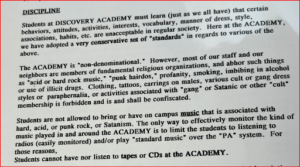
My parents were sold a bill of goods. There was no consumer-driven internet in the early 1990s to do research, no Yelp reviews, no human rights organizations or Facebook campaigns, so they likely just believed the doctor and the educational consultant in a time when they too were most vulnerable. They believed they had no choice, and this was a matter of life and death.
It was easy to believe that things were somewhat normal at Discovery Academy. If we were the right level in the ranking system, we were able to go on outings and come home for Christmas, even have visits from family to go skiing. But there was also solitary confinement, social shaming, isolation, poor education, religious indoctrination, punishment for symptoms of mental illness or trauma, forced medication, brainwashing, inappropriate and abusive pelvic exams, and the use of physical force to subdue students. Regardless of how thick the curtain of denial that has fallen across the eyes of the parents who shelled out cash for these places, no one can openly say that these tactics are therapeutic, evidence-based, or a normal part of high school, and many of them are not legal in state-run facilities.
The owner and director of Discovery Academy was Dr. T. He was a very successful man, and created a programme and curriculum designed after years of research (and research abuse, in the form of gay conversion therapy and aversion shock treatments) in the field of psychology and behaviour modification. Dr. T had a doctorate in psychology and was a lawyer, with a certification in hypnosis and behavioural modification. He was also an educator at Brigham Young University and had a psychology residency programme that taught his methods to generations of psychology students in the area.
In 1982, Dr. T had been the executive director and co-owner of a behaviour modification programme in Utah and was sued by former students in a class action suit for fourteenth amendment violations including the use of coercive polygraph testing, monitoring and censoring of mail, the use of isolation rooms, and excessive physical force. The courts found that since these private school children did not commit crimes, and were placed in facilities by their parents, the laws protecting youth in the justice system did not apply to them. As many of these schools do in the face of legal trouble, they rebranded and created sister schools that mirror these practices and continue to do so to this day. By the 1990s Dr. T had opened Discovery Academy and was the owner and director for decades.
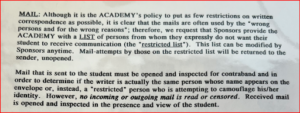

I have found throughout my life that I can survive the darkest depression imaginable; even when I fall into a black hole that seems endless, I have managed to live through it. There is an actual place that runs through the core of my body, that hurts physically and is agonizing mentally and emotionally. It feels as though all my cells are screaming in pain when I fall into that space. It is a place where joy gets eaten by darkness and there is a total recoil from connection with other people. I believe that place was born in Provo, Utah during the years of 1993-1995 in a place called Unit One.
Leonard Cohen: “You Want it Darker” — A million candles burning for the help that never came…
Unit One was the solitary confinement cell at Discovery Academy and was used primarily for punishment in my case as I was never a risk of harm to self or others. I had several stints in Unit One, the lengthiest of which was for kissing a girl. I got hundreds of demerits and close to two months’ time in a small brick cell with no windows. Consequences at Discovery Academy were flexible and were continuously changing. Expectations shifted rapidly and created an environment where you were never truly free from the risk of violating the rules. When I began researching my story during the pandemic, I found a picture posted on Yelp of a student in Unit One. I had seen other solitary confinement cell images in the media, but this was my Unit One. When I saw it, I had the sensation that one gets when they are almost hit by a car — the feelings rushed in all at once and cut me in half. At that moment I understood that this is my “treatment-resistant depression.”

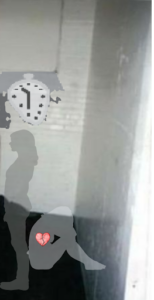 Unit One: Modified Graphic of Solitary Confinement Cell at Discovery Academy (photo of cell retrieved from Yelp). One Demerit = standing facing the wall for 25 minutes, rest for 5. Repeat…
Unit One: Modified Graphic of Solitary Confinement Cell at Discovery Academy (photo of cell retrieved from Yelp). One Demerit = standing facing the wall for 25 minutes, rest for 5. Repeat…Until recently I was still repeating the narrative that had been written for me years ago, that they all had no choice: I was out of control, I was going to die. But during the pandemic I was stuck in solitary confinement again, knowing a level of pain, aloneness, and abandonment no child should know — the pain and aloneness of Unit One — and not understanding where I was or how I got there. Being controlled by outside forces, having no agency and little support. It was all buried deep in my consciousness and inaccessible to my overmedicated, dopamine-starved brain. It was extremely “treatment resistant” because it was not depression, it was trauma, and all they ever did was treat my trauma by causing more.
The first thing that happened when I finally came off mood stabilizers was a return of the dreams. It had been 30 years since I had a dream, and even though they are still vivid and horrible, I actually feel grateful for them because it might mean I’m getting closer to where I was before they stole my capacity to dream and then punished me for them.
The level system
The level system is used in behavioural modification programmes as a ranking system to dish out privileges and punishment. It is also a way to destroy solidarity and unity with peers, create competition in peer groups, and demolish trust. Monthly level assessment meetings are a way for authorities to gain information froxxm students about other kids with the promise of the fulfilment of basic human needs for rewards. Community engagement, being able to go outside, food and treats, even home visits and trips with family are all dangled as rewards at level meetings. But those basic privileges often come at the price of interpersonal relationships among the students and have a lasting imprint on the way people interact in the world for the rest of their lives.
In my programme, the levels went from minus one to plus four. At level minus one a person is deprived of shoes, very likely in solitary confinement due to being a “run risk,” and not allowed to participate in any community activities or talk to peers. They may even have a “standing order” between themselves and others, meaning that they cannot get within a certain distance of individuals or even the entire community. Contrasted by the rare few that ever reach a four plus. These kids may be able to leave campus alone, have a job, eat outside food, go on home visits. Most kids stay within a level two to level three and are shuffled around in large white institutional vans to activities like trips to the temple, Taco Bell, the gas station, and bowling or hiking on the weekends.
Even though I believe that many of the staff were too inexperienced, young, undereducated, and untrained to understand the scope of these practices, the programme was designed with very clear intention. These tactics were an effort to dismantle solidarity, withhold community, instil fear, and use psychological torture to control and oppress children and they were no random accident.
I later discovered that many of the adults that surrounded me during those years now have a laundry list of complaints against their licenses, including the neuropsychologist who assessed me and many of the doctors. Complaints range from medical records fraud to whistleblower complaints from other doctors for questionable diagnoses and inappropriate prescribing practices. And that the education consultant that recommended the facility in Utah was also accredited by the same people that run the schools, and that the industry is known for deceptive marketing to parents. Despite the full awareness of Congress and hundreds of deaths in these facilities, little has been done to stop this pipeline or enact standards in private pay facilities that house troubled teens. (For more information, see this video from the 2008 congressional hearing, and the full hearing document).
The tendrils of the 1990s psychiatric assessments would follow me to the ends of the earth and beyond. And despite well-documented evidence that vivid dreams and night terrors are linked to the all-too-common diagnosis of PTSD, Dr. P’s wild dream theory followed me to California in the form of a 2007 fax from my mother to my new psychiatrist that read:
…here are the medical records and neuropsychiatric testing from childhood. We got a second opinion in 1992 from Dr. P who went to Harvard. He said that her dreams and the fact that she needed phenobarbital as a baby were evidence of her bipolar diagnosis. I hope this helps.
The childhood assessments were well accepted by my psychiatrist in California, who I would later discover was on the top 50 list of psychiatrists with license violations for receiving kickbacks in the form of six-figure salaries from Big Pharma, as revealed in a ProPublica report. A previous patient had filed a complaint against this provider, and although it was not disclosed to me at the time, she was on probation for gross negligence when I joined her practice. Of course, I would discover this many years after she launched full-scale chemical warfare on my brain that led me to a near career loss, short-term disability, 14 rounds of electroconvulsive therapy (ECT), and left me very close to death. I filed a complaint of my own against this physician, knowing full well it would likely be dismissed. The board investigated it and determined there was not enough evidence to proceed. But that made me realize that the voices of the patients who have been harmed by doctors are often hidden in complaint files, and that helped me later when I was trying to put the pieces together of my fragmented trauma history.
Simon and Garfunkel: “The Sound of Silence” — The words of the prophets are written on the subway walls…
Finally, un-diagnosed
It wasn’t until I left California a few years ago that I started working with TB, the doctor who finally un-diagnosed the bipolar disorder, recognized the extent of my trauma, and saw a hormonal component to my experience of the world. I have worked very hard over the last few years to find the truth so I can find a path forward. Two other doctors followed suit and recommended tapering off most of the medications I was taking over time. Although I do still take a small amount of medication, I am only taking one, as opposed to over a dozen different psychiatric medications at any given time, many of which were in the same drug class, and none of them really showing much evidence of efficacy.
I am also doing EMDR and physical therapy and occupational therapy for my pain syndrome that turned out to not actually be all in my head. I have come to understand that I am a person that experienced the world differently than many people from the moment I was born. I was sensitive, had a gifted and neurodiverse brain, and likely a temperament mismatch with my parents. I did not fit into the classroom the same way the other kids did even though I was a social and outgoing child. I had big ideas, big emotions, big fears, an active imagination, and a nervous system that felt everything at a heightened level including physical and emotional pain. But sadly, the world is not made for children like me, and the systems designed for support are broken.
I did not come out of these experiences physically unscathed. I have chronic health issues related to the medications I have taken, I am currently in a battle with gabapentin withdrawal that has been more impactful than I anticipated, and my body has been in a constant state of fluctuation between side effects and withdrawal for decades, desperately trying to balance the unknown and widespread effects these chemicals have had on my physical and mental wellbeing.
Over the last year I set out to find the truth about what happened to me. I was un-diagnosed years before, but at this point I began to ask myself, if I didn’t have bipolar disorder, then what was wrong with me, how did I end up in Utah, and how could it all have been justified? The extremes of the interventions initiated by my psychiatrists and the abusive use of gynecology throughout my story were my first clues that even 30 years ago, none of those practices were evidence-based. I decided that the only way I could learn about myself was to research the adults that made the decisions that shaped my life years ago. What I found were numerous patient complaints, often dismissed and closed with rationales such as: “Do we want to go fishing in a mental health area?” To the medical quality commission and boards of medicine everywhere: Yes, please, go fishing… you owe us all some quality and standards.
 1998 dismissed whistleblower complaint review
1998 dismissed whistleblower complaint reviewQueen: “I Want to Break Free” — I want to break free from your lies, you’re so self-satisfied I don’t need you…
Solitary confinement is not just abuse, it is torture
In 1984 The United Nations held the Convention against Torture and Other Cruel, Inhuman or Degrading Treatment or Punishment. In 1989 they met again and outlined several human rights articles pertaining directly to children. In both of these instances, the use of solitary confinement has been examined in the context of the United States prison system and warfare, and emerged as a psychologically damaging violation of human rights. The troubled teen industry has flown under the radar, engaging in torture tactics, human trafficking, and countless other offenses in the name of profit. For decades these largely unregulated private pay entities have normalized human rights violations and directly contradicted these international standards.
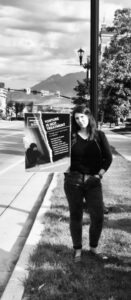 I want to see a world where solitary confinement is recognized as torture and becomes illegal for children in all states, regardless of whether the facility is public or private. A world where these schools must employ licensed teachers, social workers, therapists, and registered nurses. Children should never be placed in a facility devoid of mandatory reporters and people legally bound to protect them, with no way to contact law enforcement or Child Protective Services. These conditions leave children with absolutely no recourse to report abuse or get help if it is needed. All schools whether public or private should practice evidence-based interventions and have independent oversight of their methods, regardless of parent consent.
I want to see a world where solitary confinement is recognized as torture and becomes illegal for children in all states, regardless of whether the facility is public or private. A world where these schools must employ licensed teachers, social workers, therapists, and registered nurses. Children should never be placed in a facility devoid of mandatory reporters and people legally bound to protect them, with no way to contact law enforcement or Child Protective Services. These conditions leave children with absolutely no recourse to report abuse or get help if it is needed. All schools whether public or private should practice evidence-based interventions and have independent oversight of their methods, regardless of parent consent.
I have come to recognize that the American medical system has been used by private interest groups and Big Pharma as a massive tool of oppression that propagates stigma and exploits people for profit. Doctors must break free from the bondage of a broken, profit-driven healthcare system and go back to the roots of a profession built on evidence and bound by ethics to become the healers, educators, advocates, and seekers of truth that they truly should be.
Editor’s Note: This post was originally published on Mad in America, and is shared here with permission.
